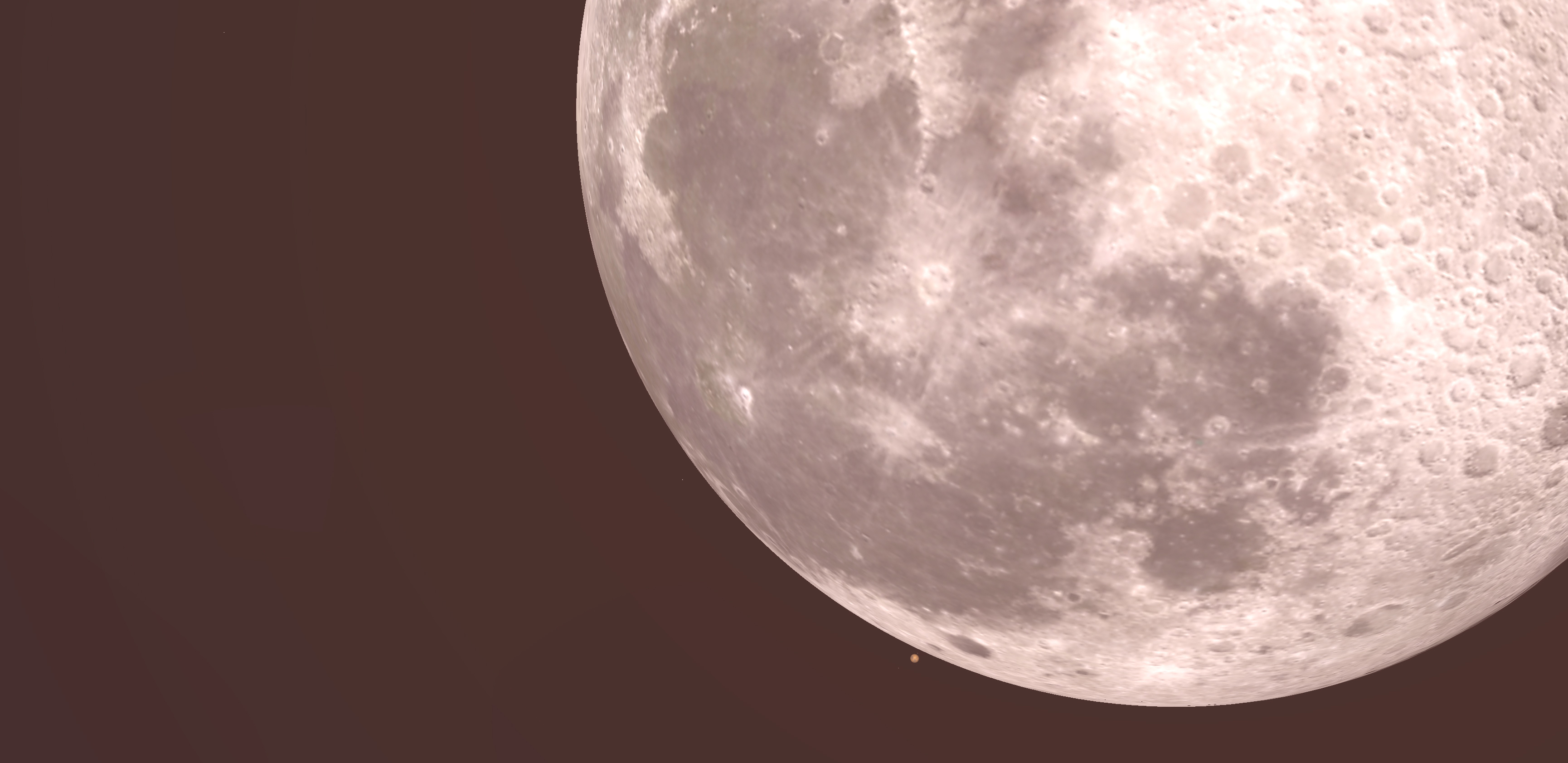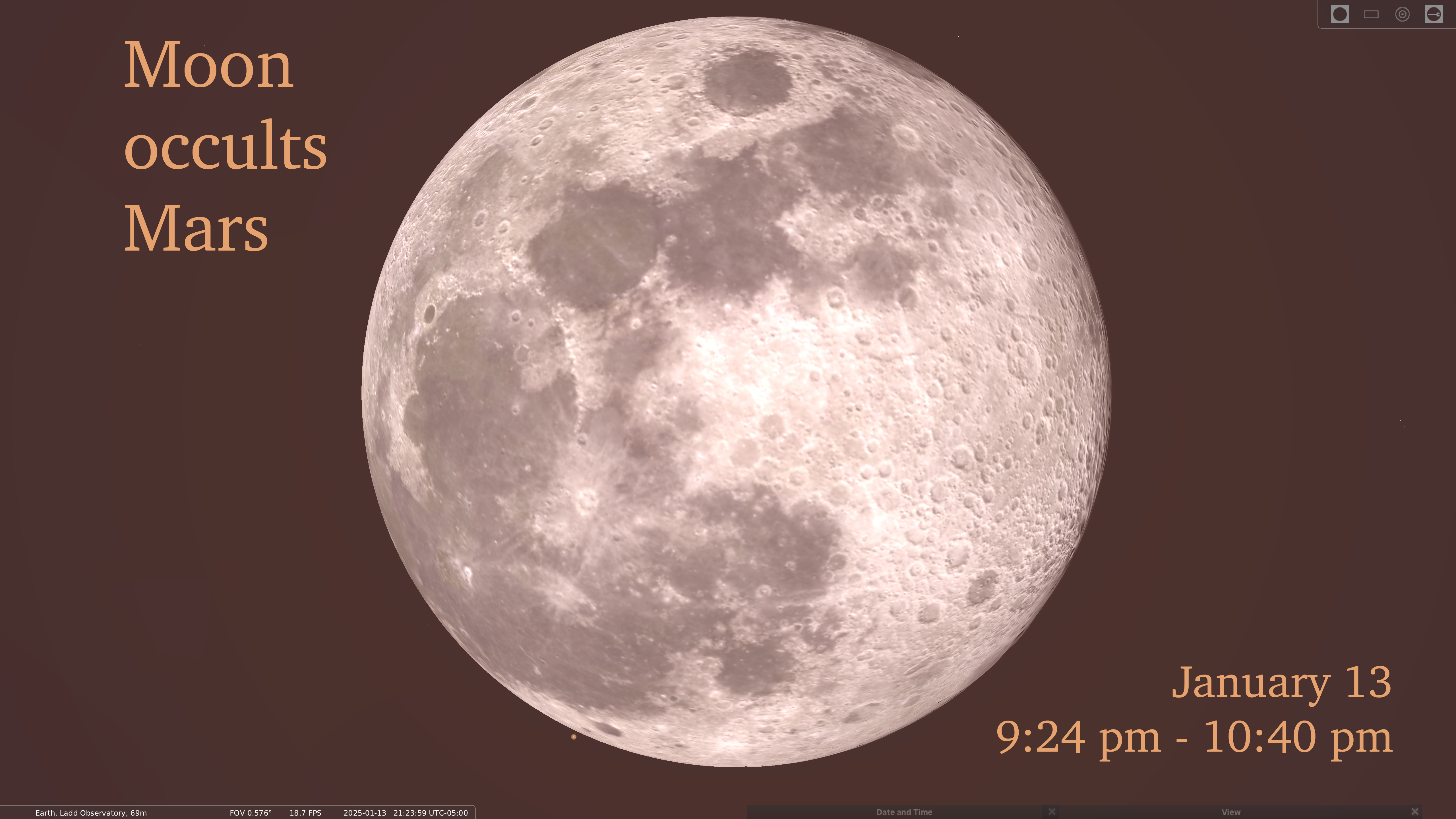
Skylights: January 2025
January 2025 :
Note: This article may contain outdated information
This article was published in the January 2025 issue of The Skyscraper and likely contains some information that was pertinent only for that month. It is being provided here for historical reference only.
Sun
The latest sunrise of the year occurs at 7:13am on the 3rd.
Earth reaches its closest point in its orbit to the Sun, known as perihelion, on the 4th, when we’ll be just 0.983327 au (147.1 million km; 91.41 million mi; 382 lunar distances) away, which is 0.03317 au (4.96 million km; 3.06 million mi; 16.55 light seconds; 12.91 lunar distances) closer than the aphelion distance in July, or about 3.37% closer.
The Sun crosses into Capricornus on the 19th, where it will spend the next 27.5 days.
The first day of the year with at least ten hours of daylight (the interval between sunrise and sunset) occurs on the 31st.
Moon
The waxing crescent is 2.7° east of Venus on the 3rd, 2.2° east-northeast of Saturn on the 4th, and 4.2° northeast of Neptune on the 5th.
The Moon is first quarter, in Pisces, at 6:56pm on the 6th.
On the 9th, beginning at 7:10pm, the 82.5% waxing gibbous Moon begins to occult the Pleiades. Occultations of the bright members of the cluster end at 10:30pm.
The Moon joints Jupiter, 4.8° to its south, on the following evening, the 10th. On the 11th, the 95.4% illuminated gibbous Moon is 4.2° east of Elnath (beta Tauri).
The full Wolf Moon occurs at 5:27pm on the 13th, in Gemini. It rises at 4:12pm, and appears 2.7° south-southeast of Pollux two hours later. At 9:24pm, it occults Mars, which reappears at 10:40pm. The Moon sets at 8:02am.
Later on the 14th, it is just 2.1° northeast of M44, the Beehive cluster in Cancer, and on the 16th, it is 3.7° east of Regulus, in Leo.
The waning gibbous Moon is 0.9° southeast of Spica, in Virgo, at midnight on the 21st. Last quarter Moon occurs at 3:31pm on the 21st.
On the 24th, the waning crescent Moon occults pi Scorpii, with ingress at 4:35am, and egress from the dark limb of the Moon at 5:12am.
The 17.7% illuminated crescent Moon is 5.6° east-southeast of Antares on the 25th.
The Moon is new on the 29th, marking the beginning of Lunation 1262.
On the 31st, the waxing crescent Moon is 3.5° west of Saturn.
Mercury
At the beginning of January, Mercury moves through Ophiuchus in the morning sky, and rises about 90 minutes before sunrise.
Rising later each morning, Mercury becomes difficult to observe by the third week of the month.
Venus
Venus is visible in the southwestern sky for nearly four hours after sunset. The 17.9% illuminated crescent Moon appears 2.7° to its east on the 3rd.
Venus reaches its greatest elongation on the 9th, extending to a maximum of 47.1° east of the Sun. The planet’s disk is 50% illuminated on the 11th, appearing like a quarter Moon, and will become an increasingly narrow crescent phase from now until inferior conjunction on March 22.
Also watch Venus as it continues to close its apparent distance from Saturn each evening until the 18th, when the brilliant Evening Star is just 2.2° north-northwest of the ringed planet.
Use Venus to locate Neptune on the 31st, when the distant planet will be 3.2° to the south-southeast of the brilliant planet. Neptune is 58 times more distant than Venus, and shines 1/100,000th as bright.

Mars
Mars is at its best in January 2025. The Red Planet is closest to Earth, at 0.642 au, at 9:00am on the 11th, when its fully-illuminated disk is 14.6 arcseconds across, and shines at magnitude -1.46, rivaling the brightest star in the night sky, Sirius. The ruddy hue of Mars is now quite apparent.
Mars is occulted by the Full Moon on the 13th, beginning at 9:24pm and ending at 10:40pm.
Mars reaches opposition four days later, on the 16th. On that evening, it appears as a “third twin,” as it is in alignment with the twin stars Castor and Pollux, in Gemini.
As it continues moving westward, Mars crosses the line connecting Pollux and Procyon on the 21st, placing it back within the Winter Hexagon asterism. It remains within the hexagon until April 2.
Jupiter
Jupiter is located a few degrees northeast of Aldebaran in Taurus, and is well-placed for observing in the evening throughout the month.
On the 2nd, Europa and Callisto are visible to the east of the planet, while Ganymede is occulted, and Io is in transit. Ganymede begins to emerge at 6:51pm, while Io begins to emerge from Jupiter’s limb at 7:11pm. Ganymede then begins to go into Jupiter’s shadow at 7:15pm, taking 13 minutes to become fully eclipsed. It then begins to emerge at 9:42pm.
An unusual grouping of the four Galilean satellites occurs just after twilight on the 5th, when the four moons form an uneven quadrilateral with the clockwise arrangement of Io, Callisto, Ganymede and Europa.
Early in the morning of the 8th, the Galilean satellites appear in order of their orbital distance from Jupiter.
Another simultaneous transit of Io and occultation of Ganymede occurs on the 9th and 10th, with Io going into transit at 6:45pm, followed by Ganymede going into occultation at 8:12pm. Io reemerges at 8:57pm. Ganymede reemerges at 10:17pm, then goes into eclipse at 11:37pm. It remains eclipsed until 1:37am.
On the 12th, Jupiter lies on a line connecting Capella and Aldebaran.
A tight formation of Jupiter’s moons occurs on the 13th, with Europa to the east, and (from north to south) Callisto, Io, and Ganymede to the west of the planet. The three moons form a perfect line at 9:02pm. Europa then transits the planet, and joins Callisto and Io, forming a perfect line at 2:45am on the 14th.
Io and Ganymede appear close to Jupiter’s eastern limb at 11:00pm on the 16th.
On the evening of the 19th, the four Galilean moons appear in order of orbital distance from Jupiter.
At 11:58pm on the 22nd, Europa emerges from eclipse on the eastern side of Jupiter, joining Io and Callisto on the opposite side of Jupiter in a tight formation. Ganymede remains extended farther to the west.
Jupiter makes its closest pass to Aldebaran at the end of the month, coming to within 5.1° of the brightest star in Taurus. It will then depart our sky by 3:00am, setting in the west-northwest.
Saturn
January is the final month to get a good view of Saturn until it sets too deep into evening twilight, before returning to the morning sky later in spring.
The 27.3% waxing crescent Moon is 2.2° east-northeast of Saturn on the 4th.
Saturn is visible in the early evening sky, now notability west of the meridian after sunset. Watch as Venus appears to approach the ringed planet from the west each night. Venus overtakes Saturn in January, with the two planets appearing level with the horizon on the 17th, and closest, at just 2.2°, on the 18th.
Saturn departs the evening sky by 8:00pm at the end of the month.
Uranus
Uranus is high in the southeast after twilight, making it well-placed for evening viewing throughout the month.
Find Uranus by locating Botein (delta Arietis), a magnitude 4.4 star located 9° southwest of the Pleiades. Uranus is located 3.2° east-southeast of Botein.
The seventh planet reaches its stationary point on the 30th, then resumes its prograde (eastward) motion.
Neptune
As with Saturn, the most opportune time to observe Neptune draws to a close in January, as the most distant planet moves lower in the southwestern sky each evening. The magnitude 7.8 planet can be found 4.6° southeast of lambda Piscium, and 1.0° northwest of 24 Piscium.
Brilliant Venus joins Neptune on the 31st, when the pair is separated by 3.2°. Neptune then departs the evening sky before 9:00pm.
Minor Planets
Ceres, in Capricornus, is too deep in twilight to observe.
Pluto, which reaches conjunction later in the month, is also not observable.
Asteroid 4 Vesta is moving eastward through Virgo. It is about 10° northeast of Spica in early January. It shines at magnitude 7.7.
Asteroid 3 Juno, at magnitude 11.3, is just 0.4° southwest of magnitude 0.0 Zubeneschamali (beta Librae) on the 4th.
The Quadrantid meteor shower is active from late December through mid-January, but its brief peak occurs during daylight hours of the 3rd. The meteors appear to radiate from a point in northern Bootes, which is circumpolar, so the best opportunity to observe them is during the early morning hours of the 3rd.
Stars
Perhaps the most anticipated celestial event of 2024, the once-per-80-year outburst of recurrent nova T Coronae Borealis, is yet to occur as 2025 dawns. Its resident constellation, which marks the northern crown, is best seen in the predawn sky during January, when it will be midway up in the east, below and to the left of Arcturus.
Simulated view of January 13's lunar occultation of Mars using Stellarium



